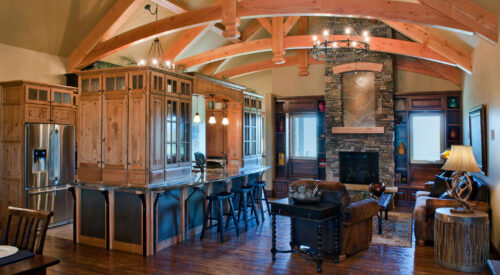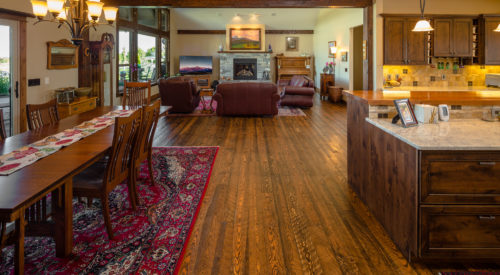
Product Lifecycle Energy Consumption and Renewability
Mar 04, 2020

Wood Siding, Vinyl Siding, and Fiber Cement Board Siding
The Immediate Environmental impact from a particular siding choice can widely be understood by examining the energy required to manufacture and bring products to market and then distributed and installed. Longer-term effects require us to look at the end of the product lifecycle—where do natural wood siding, vinyl siding, and fiber cement siding go to die? Let’s take a look at just how energy efficient and sustainable natural wood siding products can be!

Manufacturing
Wood siding products require energy to manufacture. It takes energy to get logs to mills, to break logs into boards, to dry boards, and to remanufacture them into siding products. It takes energy at each stage to drive wood through the manufacturing process.
When we look at energy efficiency inside of the manufacturing process, there are specific approaches in each stage that we undertake to be as effective as possible. For example, many types of dry kilns are highly energy-efficient, using the energy released in the drying process to heat the kiln chamber. As an efficient practice, this dramatically reduces the amount of energy it takes to produce natural wood products. Also, biofuel is used widely at lumber manufacturing facilities. Carbon released using biofuel from sustainably harvested materials would re-enter the atmosphere similar to the way that dead trees decompose. As a result, the net carbon released is extremely low.

Transportation
The key consideration in the transport of products is the energy expenditures associated with that shipment. It is also focused on the weight of load and volume of shipment in comparison to other materials. Wood siding energy consumption is in the middle of the pack when it comes to transportation over a certain distance. The volume transported is higher per the amount of wall covered than fiber-cement products, but its weight is lower per coverage area. For the most part, wood requires less energy than fiber cement to ship.
Vinyl siding is less costly to ship the same distance than wood and far-less than fiber-cement. The weight-per-coverage area ratio is very low.
One advantage that wood sidings can have is that you can source products produced more locally in almost all geographic areas in the US than either vinyl siding or fiber-cement. So while the wood siding is heavier and a little less efficient to transport, the distance required to bring products to market can be far lower. This drastically decreases the amount of energy necessary to get wood siding from the manufacture location to your job site.
Recyclability
The recyclability of wood depends heavily on the coverings used during the service life of the siding. If toxic coverings are used in the maintenance process, many recycling agencies will refuse to reuse the material. Many landfills have wood recycling programs. It is a great way to get rid of clean construction site waste and preserve non-toxic materials to reuse with other products. Sidings that have non-toxic and water-borne treatments can easily be recycled. This helps buffer the cost of energy, as reused material allows logging and forestry efforts to enable another source to partner with the output of lumber.

Renewability and Carbon Sequestration
Natural wood siding is the only one of the very cost-effective, common cladding materials that are entirely renewable and sequesters carbon for the entire service life of the material and beyond. Carbon sequestration is the natural outcome of photosynthesis supplying plants (trees!) with energy to grow.
Properly managed, healthy forests can grow new wood-fiber faster than unhealthy, overgrown forests. As a result, they also sequester carbon at a higher rate. No other widely used siding material can sequester as much carbon over a long period of time as natural wood products. Sustainably harvested lumber allows carbon capture to happen faster, but all timber products sequester carbon from the atmosphere as long as the product is in service.
Carbon that is sequestered in trees eventually returns to the atmosphere either as that tree burns or decomposes. These processes can be delayed a great deal through the modern, efficient manufacture, installation, and maintenance of wood building products. There is a lot of information about carbon sequestration in wood products, click here for an article from USGS. Properly installed and maintained wood siding will sequester carbon for as long as the building is standing. Just another reason that proper installation is so crucial.
Conclusion
Holistic energy analysis of the entire product life-cycle of timber siding products makes it clear that wood-siding can indeed be an environmentally friendly siding choice. Choosing a product that is locally produced by a manufacturer is only one part of it. Finding one who is serious about using responsibly sourced logs harvested using industry-standard best management practices, like Marks Lumber, only increases the benefits of natural wood siding.
Learn More About Our 105 Siding/Channel Rustic Products
View 105 Siding/Channel Rustic ProductsOther Posts
Jan
2023

Five Timeless Interior Design Trends
When it comes to interior design, it may feel daunting to keep up with the ever-evolving trends that come with each passing season. Well, we're here t...
Jan
2023

Lumber Textures Defined
Lumber comes with the benefit of versatility. One of the simplest ways to create intrigue with lumber products is by using different textures. Circle ...
Dec
2022
Tips for Using Radiant Heating with Wood Floors
One of the best parts of living in Montana is experiencing all the seasons – and yes, we include wintertime. However, as much as we may love the...